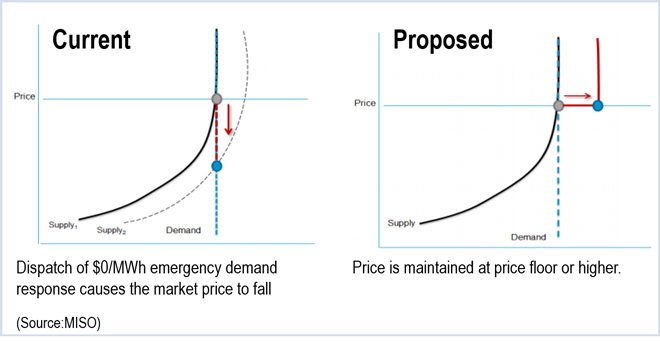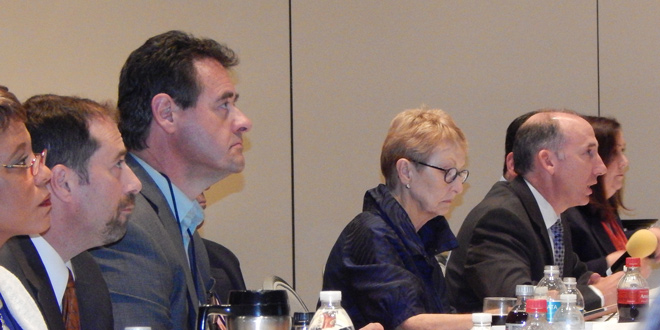By Suzanne Herel
ATLANTIC CITY, N.J. — The eye of Superstorm Sandy swept over this city nearly three years ago, leaving 2.8 million residents without power. That made the Borgata Hotel Casino a fitting spot to debate the value and challenges of microgrids, Richard Mroz, president of the New Jersey Board of Public Utilities, told a group at PJM’s biannual General Session.

“Sandy had a cascading effect on all critical systems,” he said, highlighting their interdependency and the role microgrids could play in strengthening their resiliency against natural, accidental and manmade threats.

“It’s resulted in debates over the grid — the role of generators, distribution companies and regulators,” he said. “It’s a discussion worth all of our efforts.”
Joined for a roundtable on just that topic were Michael Burr, director of the Microgrid Institute; Lawrence Jones, North America vice president for utility innovations and infrastructure for Alstom; Micah Kotch, director of the New York Prize program at the New York State Energy Research and Development Authority; Thomas Nyquist, executive director of engineering and campus energy for Princeton University; and Thomas Fenimore, technology development manager for Duke Energy.
‘Nested’ Microgrids
Centralized grids are reliable but not resilient, Burr said. That’s where distributed energy technologies can step in.

In particular, he pointed to a trend of “nested” microgrids, where critical facilities such as hospitals and water towers that are located in different areas of town can be served by a cluster of “nodes.”
One such community is the Olney Town Center in Montgomery County, Md., part of a U.S. Department of Energy technology research program to study microgrid models. When completed in the fall of 2016, the community’s six nodes will operate together during normal conditions to maximize economic efficiency and “island” during outages to preserve resiliency.
However, there are challenges to such a model, he said. The nested architecture contains more points of coupling, requiring more interconnection and safety equipment, Burr said. In addition, non-critical loads must be disconnected during islanding.
Princeton Keeps the Lights On
Nyquist brought to the table Princeton University’s experience operating two generators on campus to serve the school’s need for power for labs and data centers. During Sandy, it was this energy independence that saved 50 years’ worth of DNA research, he said.
Princeton uses energy from the PJM grid at night, when the prices are lowest, and generates its own power during the peak period.
“We save a lot of money doing this, but it also reduces load on the grid,” he said.

Kotch likened the innovation erupting in the energy industry to the disruption that tech companies such as Uber, Facebook, Alibaba and Airbnb have effected in their spaces — none owns a product, but they’re providing services that have eclipsed their brick-and-mortar competitors.
“Thomas Edison would be the first to agree that energy isn’t about moving commodity but delivering services,” he said. “Utilities have traditionally thought their business ends at the meter. That notion is fundamentally trying to change. There is this customer pull — not a top-down push — for more control.”
Outgoing PJM CEO Terry Boston agreed. “I think choice and control are going to drive microgrids as much as economic viability,” he said.
Energy as a Service
Jones also spoke of the idea of rethinking energy as a service.

“If kilowatt-hours are not selling, if they’re reducing … how do we evolve from a kilowatt-hour approach to more of a service model?” he asked.
He recounted the experience of one African region where residents were so used to the government subsidizing electricity that they were unwilling to pay for it. What they valued, however, was refrigeration — so they paid more for that in a bundle of services, which made up for the low price of electricity.
Such a paradigm change, Jones said, is where regulators must get involved.
Other core issues, he said, are whether microgrids can benefit the overall transmission system and how to quantify the value of distributed energy.
“How will the markets evolve?” he said. “How do we unlock the value of distributed resources? Do we keep the assumptions we’ve had?”
As for whether microgrids are considered evolutionary or disruptive, “It’s all relative to who you’re talking to,” he said, and depends on where you are in the world.
Value

Fenimore, of Duke Energy, echoed some of Jones’ questions.
“We know how to operate and build these assets,” he said. “How do we integrate these newer technologies … and then how do we understand in a regulated space what the value of that is on the market side?”
To address the changing landscape, Duke in 2014 created the Distributed Energy Resources Group. Fenimore highlighted the company’s energy storage efforts, which charge and discharge based on market signals to help maintain grid stability.
Boston, who did his graduate thesis on the optimization of energy storage, applauded the project.
“I’m for storage,” he said, adding, “I did learn something today, and that was about the innovation and change that are inevitable here.”











